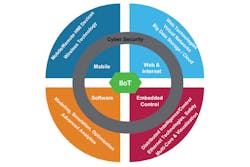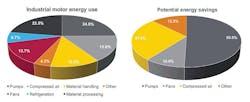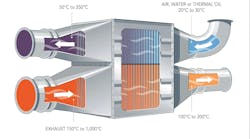The Industrial Internet of Things – or IIoT – is a buzzword these days, featured in an increasing span of technical discussions and the topic of an increasing number of technical documents. On most occasions, it is directly linked to the concept of “smart machines.” But, while it is clearly a phenomenon that provides enhanced manufacturing performance, it also provides services and benefits well beyond the factory floor.
The concept of “smart pumping” has been implemented as a recent solution that incorporates controls, sensors and software to drive pump system regulation. This ultimately results in energy savings and a decrease in overall operational costs.
But IIoT takes it further, incorporating machine learning and Big Data technology to go to the next step of pump system optimization. IIoT is increasingly being applied in pumping whether it be on the factory floor in industries such as food and beverage, or in remote applications in industries such as oil and gas, water and wastewater and mining.
IIoT provides a vision with smart, connected assets with varying levels of functionality operating as part of a larger system. While historically these assets have communicated using traditional communication protocols, IIoT is bringing new elements and greatly expanded sensing capabilities into play.
Numerous drivers are pushing this trend forward. Some of which include increased cost/price pressures, globalization, and a lack of financial resources/support, among others. However, many benefits can be realized from implementing such systems. Some of the key benefits include:
Energy efficiency
A somewhat lesser-known fact is that pumps consume close to 25 percent of all industrial motor energy use. Another fact is that pumps represent more than 50 percent of total energy savings potential.
A smart pumping system, along with IIoT, enables better energy management through the monitoring of pumps. This can help operators detect increased energy usage and make adjustments as needed. Further, with libraries and algorithms to ensure that pumps are running in an energy-efficient manner, operators can optimize their systems over the longer term.
Water efficiency
Water scarcity has become a global concern as it affects every continent and approximately 2.8 billion people around the world. Therefore, the need to design water-efficient systems and increasingly monitor ongoing usage is a growing priority among numerous industries such as agricultural and commercial irrigation. The ability to remotely monitor and control water usage provides a partial answer to this issue around the world.
Predictive/preventive maintenance
Companies understand the importance of process uptime, both in terms of profitability and customer service. Therefore, many have put strategies in place to identify issues before they cause process failures and schedule maintenance at a convenient time that allows them to optimize their operation. The advantages of such strategies include decreased downtime, increased equipment efficiency and improved overall efficiency.
Managed maintenance resources
By planning when maintenance will take place, resources can be better managed around those cycles. Budget, for example, can be allocated based on previous maintenance estimates to cover the anticipated parts and labor costs of that maintenance. Skilled labor is also a large challenge with many plants facing a lack of manpower to dedicate to maintenance and a lack of specialized skill among current staff. By scheduling maintenance, those with the specialized skills required can be identified and brought in on a project basis to manage that maintenance. By better managing maintenance resources, maintenance costs can be reduced and the issue of a lack of trained/qualified resources can be addressed.
Enhanced safety
Safety is an often-overlooked benefit since it doesn’t appear on a spreadsheet until an incident has occurred. However, regular operation maintenance helps to ensure greater efficiency and fewer breakdowns. Those fewer breakdowns mean less chance of someone being injured when a machine or operation fails. There is also a lower likelihood of an unqualified or underqualified person trying to hastily make repairs on a machine to get an operation running again.Practical applications
Human machine interfaces (HMIs), programmable logic controllers (PLCs) and variable speed drives (VFDs) all have features that can help to monitor a system or machine and alert to potential issues before they occur, preventing unnecessary downtime. PLCs containing web visualization allow users to create a webpage showing necessary information for the machine or system. Having this ability lets users remotely monitor their system or machine, make changes to parameters and look for changes in data that the user is logging to show when a potential problem may be arising that will require maintenance.
This ties into the IIoT evolution because PLCs with network connectivity and input/output (I/O) capabilities are able to collect and process data points in a distributed manner. The data collection can then be presented in visualizations for maintenance, monitoring and control optimization purposes.
PLCs containing webservers allow the user to share specific data points with the webserver. This allows users to remotely look at the operation of the machine or system from a computer, either onsite from an office or from an offsite location. Users have the ability to read and/or write to parameters selected for sharing as well as to look at any data that is being logged and graphed on the HMI, looking for changes in system function.
Widespread usage of Ethernet networks has enabled users and operators to remotely access already-built HMI screens. Embedding technologies like VNC reduces integration and development requirements given that the screens being viewed could be mirrored views of the actual HMI screen. These features may not be new but the availability of more powerful processors and fully featured software environments allow for features like this to be embedded into devices. The end result is remote accessibility for troubleshooting and maintenance with an additional 15 minutes of simple software setup.
PLCs and HMIs offer many options for predictive and preventative requirements that can be displayed. The investment required to reap these benefits is in the design and development efforts. Feedback from system interaction over time can be iteratively used to aid the user in optimizing the system. IIoT evolutions today allow easier access to operational information and feedback to operators and plant engineers, directly from distributed PLC control, VFDs or HMIs.
Variable speed drives with embedded Ethernet, webservers and visualization tools give the user the ability to assess the operation of the drive from remote locations. The embedded webserver may have a user-customizable dashboard giving access to current critical information. Examples include the current motor and drive state, motor current and if the drive has tripped on an error. Beyond this, embedded dashboards may be able to provide additional information regarding error states along with historic trip data.
In the pumping world, many applications are in remote locations and can be difficult and/or expensive to monitor. IIoT evolutions at the device level offer end users the ability to remotely monitor operational conditions. This will reduce costs – both operating and maintenance – because field calls will become reactive and not proactive.
To get started, some immediate actions may include:
- Introduction of energy-monitoring devices into system architectures
- Use of intelligent controllers to better analyze system inputs
- Incorporation of VFDs into pump systems where energy savings potential exists
- Increased use of remote monitoring technologies for both maintenance and energy management
The technology and the application of the technology will most likely continue to evolve and users need to be aware of their options and embrace the solutions to continue to enhance their business model.
Jack Creamer is Schneider Electric‘s market segment marketing manager – pumping equipment. He is actively involved in key industry associations such as the Hydraulic Institute and the Submersible Wastewater Pump Association. He also represents Schneider’s membership in numerous industry organizations.
Jo Lockard is an application design engineer at Schneider Electric, and has been in the electrical and controls industry for 12 years. She assists OEM customers with the design and development of automation systems.






